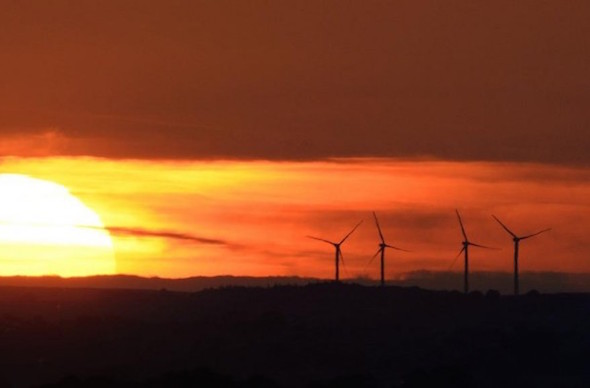Energy Game-Changers Look to the Future
Innovative new research into clean energy technology shows there are viable alternatives to fossil fuels -- provided there is enough political will and investment.
By Tim Radford / Climate News Network

New ways are being developed to capture and store maximum power from sun and wind. (lutmans via Flickr)
This Creative Commons-licensed piece first appeared at Climate News Network.
PARIS — Researchers now know how to keep the whole of the US powered by wind, water and sunlight without ever needing to fall back on emergency fossil fuel generators.
They have also discovered how to extract hydrogen from methane without spilling any greenhouse gas into the atmosphere.
And they have worked out a new and simple way to get the best available power from a wind turbine, and how to charge pocket electronic devices without plugging them into a socket.
None of these technologies is ready for the market yet, and one of them exists only on paper.
But all of them are continuing evidence of the ingenuity and resources now being invested in cracking the great planetary energy challenge: how to sidestep fossil fuel emissions, and thus stop dumping into the atmosphere the carbon dioxide that fuels global warming and climate change.
Hydrogen power
The hydrogen solution comes initially from Carlo Rubbia, Nobel Laureate and former director of the Institute for Advanced Sustainability Studies in Potsdam, and the Karlsruhe Institute of Technology. Researchers at the two German institutions have co-operated to “crack” methane or natural gas (chemical formula CH4) into its components — hydrogen and carbon.
Hydrogen already powers the fuel cells that promise to change public and private transport, but the challenge has always been to get a lot of this high-energy fuel without generating more greenhouse gases.
Black or solid carbon, too, has commercial value. The German scientists and engineers now have a new reactor design that has so far run for at least two weeks at temperatures of 1200°C, and delivered hydrogen from methane at a conversion rate of almost 80%.
“This could be a gap-bridging technology, making it possible to tap into the energy potential of natural gas while safeguarding the climate and facilitating the integration of a clean energy carrier like hydrogen,” Professor Rubbia says.
Mark Jacobson, professor of civil and environmental engineering at Stanford University in the US, has already found new ways to think about wind power, and has presented a plan for complete conversion of all 50 US states to renewable energy by 2050.
It would also create two million new jobs and insure the US against power disruption, as well as eliminate air pollution
In a report in the Proceedings of the National Academy of Sciences, he and colleagues confront the problem that solar power is only available in the daytime, and that sometimes the winds stop blowing.
They reason — their solution so far exists only in theory — that surplus summer heat collected by solar panels could be stored in soil or rocks and used to heat homes in winter, or to generate hydrogen for fuel cells. The challenge would be working out how best to respond to demand and spread the surplus around the national grid.
Such a solution would require no new technology. It would be cheaper than many other proposed storage alternatives, it would be reliable, and there would be no need for coal, natural gas, biofuels, nuclear power or enormous battery farms in what would become an all-electric world.
It would also create two million new jobs and insure the US against power disruption, as well as eliminate air pollution. All it would require would be fresh thinking and high ambitions.
Engineers at Iowa State University have just tested one high ambition — a new kind of wind turbine tower made of precast concrete hexagon components that could be stacked as high as 140 metres, to take advantage of the faster winds at higher altitudes.
Favourable winds
The concrete alternative has the edge over the present towers of steel, the Iowa scientists say. because the pieces can be precast and easily assembled on site, with lower production costs, and the towers can reach beyond 80 metres high to harness more favourable winds.
So far, “Hexcrete” exists only as a test facility. “Our goal is to build a full tower in the field,” says Sri Sitharan, the university’s professor in civil, construction and environmental engineering.
Engineers have already found ways to deliver electricity without wires. But University of Washington researchers have come up with a way of plugging into what, in modern cities, is already a ubiquitous, harmless, invisible energy supply — the radiation from Wi-Fi systems.
As a test, they charged a wearable fitness tracker from zero to 41% in 2.5 hours, and they promise their Power Over WiFi, or PoWiFi, system will one day deliver more, faster and better, without disrupting anybody’s online browsing.
It has also been tested in six homes, and the system has been chosen by Popular Science journal as one of the most innovative and game-changing technologies of the year.
Tim Radford, a founding editor of Climate News Network, worked for The Guardian for 32 years, for most of that time as science editor. He has been covering climate change since 1988.
Your support matters…Independent journalism is under threat and overshadowed by heavily funded mainstream media.
You can help level the playing field. Become a member.
Your tax-deductible contribution keeps us digging beneath the headlines to give you thought-provoking, investigative reporting and analysis that unearths what's really happening- without compromise.
Give today to support our courageous, independent journalists.






You need to be a supporter to comment.
There are currently no responses to this article.
Be the first to respond.